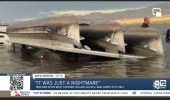LaurencetheAdventurer
Well-Known Member
I think we all realize boating conditions can change drastically in minutes. Until this prior Labor Day weekend, I had not fully appreciated that our relatively stable and safe TriToons could actually FLIP OVER! I was on the lake 10 minutes before this monsoon hit, it was mostly gone in another 10 minutes, but what a tragic sliver of time that was for this family and others.
I don't know the family, but my prayers to them for the loss of their 17yr old daughter.
I am now looking to educate myself more about this risk and how do we drive our boats when caught in sudden gale force winds and waves (experience suggests downwind or into the wind, slight angle over waves, but?).
I suspect this event occured with the TriToon sideways to the wind and a shore break wave - the combination leading to the flipped boat. No information on these details have been provided.
Also in search of a storm radar app that will provide alerts with minimal bandwidth!!
I certainly have learned I have a lot to learn! Ideally sharing may help save others!?
Have fun, but safety first!!!
I don't know the family, but my prayers to them for the loss of their 17yr old daughter.
I am now looking to educate myself more about this risk and how do we drive our boats when caught in sudden gale force winds and waves (experience suggests downwind or into the wind, slight angle over waves, but?).
I suspect this event occured with the TriToon sideways to the wind and a shore break wave - the combination leading to the flipped boat. No information on these details have been provided.
Also in search of a storm radar app that will provide alerts with minimal bandwidth!!
I certainly have learned I have a lot to learn! Ideally sharing may help save others!?
Have fun, but safety first!!!

